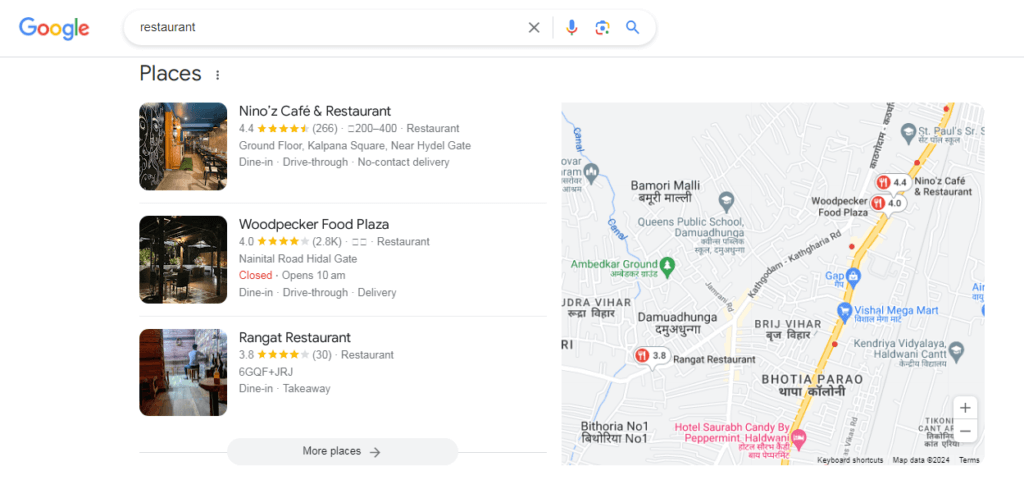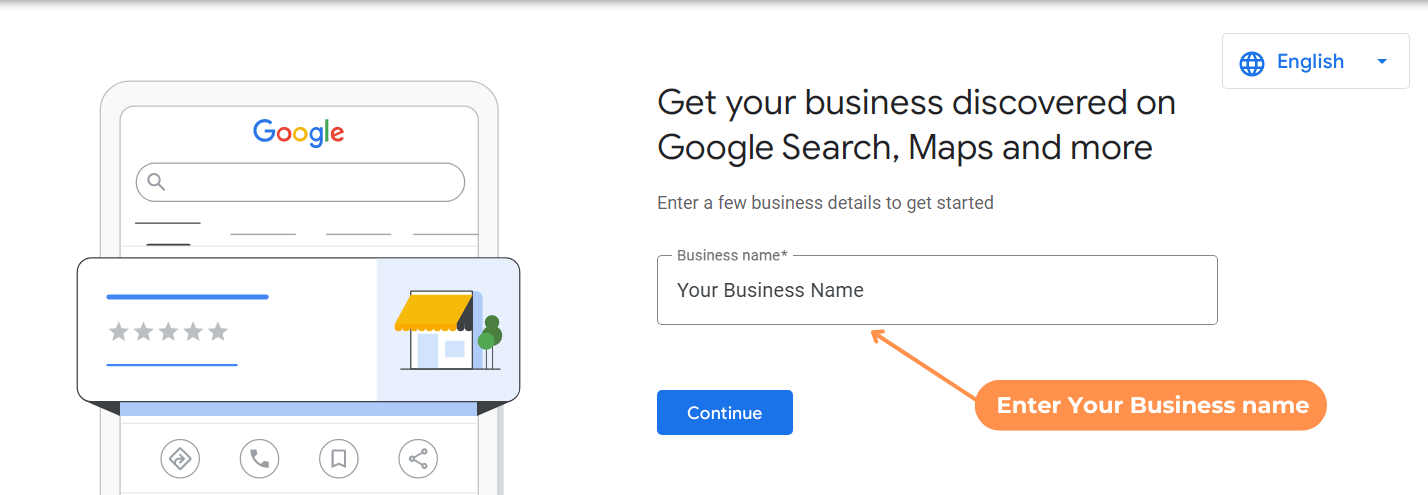Local SEO (Search Engine Optimization) is a strategy focused on optimizing a business’s online presence to attract more customers from relevant local searches.

These searches take place on Google and other search engines.
Essentially, local SEO helps your business be more visible to potential customers in your geographical area, ensuring you show up when they search for products or services you offer.
Table of Contents
Why is Local SEO Important?
Local SEO is crucial because it targets people who are actively looking for your type of business within your area. This makes it one of the most effective ways to drive foot traffic and online interactions from your local community.
With mobile internet usage on the rise, many consumers are searching for businesses on the go, making local SEO even more vital.
Benefits of Improving Local SEO for Businesses in Haldwani
- Increased Visibility in Local Searches: By optimizing for local SEO, businesses in Haldwani can appear at the top of search results when potential customers search for relevant services nearby. This visibility can lead to more traffic and higher chances of converting visitors into customers.
- Better Online Presence: Enhancing local SEO involves updating and managing your business information on Google My Business, ensuring accurate details such as address, hours, and contact information. This accuracy helps build trust with customers and improves your online reputation.
- Targeted Traffic: Local SEO drives more targeted traffic to your website, bringing in customers who are specifically looking for the services or products you offer in Haldwani. This leads to higher conversion rates as the visitors are already interested in what you provide.
- Competitive Edge: Many small businesses may not fully utilize local SEO, giving those who do a competitive advantage. By standing out in local search results, you can attract more customers than competitors who haven’t optimized their local SEO.
- Enhanced User Experience: Part of local SEO involves optimizing your website for mobile users, ensuring quick loading times, and making information easy to find. This leads to a better user experience, encouraging customers to choose your business over others.
Step 1: Claim and Optimize Your Google My Business Listing
Claiming Your Google My Business Listing
- Sign In: Go to Google My Business and sign in with your Google account. If you don’t have one, you’ll need to create it.

- Enter Business Details: Follow the prompts to enter your business details, including name, address, and category.
- Find Your Business: Enter your business name in the search bar. If your business appears in the list, select it. If not, click on “Add your business to Google.“

- Verify Your Business: Google will send a verification code to your business address by mail. Enter this code in your Google My Business account to verify your listing.
Optimizing Your Google My Business Listing
- Accurate Business Information: Ensure all your business details are correct and up-to-date. This includes your business name, address, phone number, website URL, and business hours. Consistency is key to building trust with customers and improving your local search ranking.
- Add Photos and Videos: Upload high-quality photos of your business, including the exterior, interior, products, and services. Visual content helps attract more visitors and gives them a sense of what to expect. Consider adding short videos showcasing your business in action.
- Business Description: Write a compelling and detailed business description. Include relevant keywords naturally to improve your chances of appearing in local searches. Explain what makes your business unique and highlight any special offers or services.
- Regular Updates: Keep your listing fresh by posting regular updates. Share news about special promotions, events, or new products/services. This keeps your audience engaged and informed about what’s happening at your business.
- Customer Reviews: Encourage satisfied customers to leave positive reviews. Respond to reviews promptly and professionally, whether they’re positive or negative. Engaging with customers shows that you value their feedback and are committed to improving your business.
- Add Attributes and Services: Use attributes to highlight specific features of your business, such as “wheelchair accessible” or “free Wi-Fi.” List the services you offer to give potential customers a clear understanding of what you provide.
- Utilize Q&A Section: Monitor the questions and answers section on your listing. Provide clear and helpful responses to common queries. This can serve as an FAQ for potential customers and reduce barriers to visiting your business.
Step 2: Ensure NAP Consistency
What is NAP?
NAP stands for Name, Address, and Phone number. It refers to the core contact information for your business that should be consistently displayed across all online platforms.
Why is NAP Consistency Important?
- Improves Local SEO Rankings: Search engines like Google prioritize businesses with consistent NAP information across the web. Consistency helps search engines verify the legitimacy of your business, improving your local search rankings.
- Builds Trust with Customers: Consistent NAP information ensures that potential customers can easily find and contact your business. Inconsistent information can create confusion and lead to a loss of trust, causing potential customers to choose a competitor instead.
- Enhances User Experience: Providing accurate and consistent contact information across all platforms ensures a seamless user experience. Customers can confidently reach out to your business without frustration or doubt.
- Prevents Confusion and Errors: Inconsistent NAP information can lead to errors in online directories and mapping services, causing customers to arrive at the wrong location or call an incorrect number. This can result in missed opportunities and negative experiences.
- Strengthens Your Brand Identity: Consistency in your business name, address, and phone number helps establish a strong and recognizable brand identity. It reinforces your business presence across various online platforms, making it easier for customers to remember and choose your business.
How to Ensure NAP Consistency?
- Create a Standardized Format: Decide on a standardized format for your business name, address, and phone number. Use this format consistently across all online platforms, including your website, social media profiles, and online directories.
- Audit Your Online Presence: Conduct a thorough audit of your online presence to identify all instances of your NAP information. This includes your website, Google My Business listing, social media profiles, online directories, and review sites.
- Update Inconsistent Information: Correct any inconsistencies in your NAP information. Ensure that the details are accurate and match the standardized format you’ve established. This may involve contacting directory sites to request updates.
- Monitor Regularly: Regularly monitor your online presence to ensure that your NAP information remains consistent. Set a schedule to periodically check and update your details as needed.
- Use Tools for Management: Consider using online tools and services that can help manage and maintain NAP consistency. These tools can automate the process of updating your information across multiple platforms, saving you time and effort.
Step 3: Optimize Your Website for Local Keywords
Keyword Research for Local Terms
- Identify Your Target Audience: Understand who your local customers are and what they are searching for. Consider their needs, preferences, and the language they use when searching for your products or services.
- Use Keyword Research Tools: Utilize tools like Google Keyword Planner, SEMrush, Ahrefs, and Moz to find local keywords relevant to your business. Look for keywords that include your location (e.g., “digital marketing agency in Haldwani”) and have a good search volume with manageable competition.
- Analyze Competitors: Check the keywords your local competitors are ranking for. This can give you insights into effective keywords you might have missed and help you understand the competitive landscape.
- Long-Tail Keywords: Focus on long-tail keywords, which are more specific phrases that potential customers might use. These often have lower competition and can attract highly targeted traffic (e.g., “best digital marketing services in Haldwani”).
- Local Modifiers: Include local modifiers in your keywords, such as city names, neighborhoods, or landmarks (e.g., “web design near Kathgodam, Haldwani”). This helps search engines connect your business with local search intent.
Integrating Local Keywords into Website Content
- Title Tags and Meta Descriptions: Include your primary local keywords in the title tags and meta descriptions of your web pages. This helps search engines understand the relevance of your content to local searches and improves click-through rates from search results.
- Headers and Subheaders: Use local keywords in your headers (H1, H2, H3 tags). This not only improves SEO but also makes your content more readable and organized for visitors.
- Body Content: Naturally integrate local keywords into the body content of your pages. Ensure the content remains engaging and informative, avoiding keyword stuffing. Mention your location within the context of your services or products to make it relevant to readers.
- Service Pages: Create dedicated pages for each service you offer, incorporating local keywords. For example, if you offer web design and SEO services in Haldwani, create separate pages optimized for “web design in Haldwani” and “SEO services in Haldwani.”
- Local Content: Develop content that focuses on local events, news, or community activities related to your business. This can include blog posts, case studies, or customer testimonials. For instance, write about how your services have helped local businesses succeed.
- NAP Information: Ensure your business’s Name, Address, and Phone number (NAP) are consistently listed across your website. Place this information in the footer, contact page, and any other relevant sections. Consistent NAP details help search engines verify your business’s location.
- Image Alt Text: Optimize images by using local keywords in the alt text. This improves your site’s accessibility and helps search engines understand the context of the images.
- Internal Linking: Use internal links to guide visitors to other relevant pages on your website. Anchor text with local keywords can enhance SEO and provide a better user experience. For example, link “SEO services in Haldwani” to the corresponding service page.
Step 4: Create Localized Content
Creating content that resonates with your local audience can greatly enhance your local SEO efforts. Here are some blog post ideas and content suggestions for businesses in Haldwani:
- Local Event Coverage: Write about upcoming events, festivals, or community gatherings in Haldwani. Offer tips, guides, or highlights to attract both locals and visitors.
- Spotlight on Local Businesses: Feature interviews or profiles of other businesses in Haldwani. This not only supports local commerce but also encourages reciprocal engagement.
- Haldwani Guides and Tips: Create guides for tourists or newcomers to Haldwani. Topics could include best places to eat, things to do, or hidden gems in the area.
- Customer Success Stories: Share stories of satisfied customers from Haldwani. This can build trust and demonstrate your business’s positive impact within the community.
- Seasonal Promotions and Updates: Keep locals informed about seasonal offers, new products/services, or any changes in business operations.
Step 5: Get Reviews from Local Customers
Reviews play a crucial role in local SEO as they directly impact your business’s credibility and visibility. Here’s how to encourage reviews and manage them effectively:
- Ask Satisfied Customers: Politely request reviews from satisfied customers after completing a transaction or providing a service. Make it easy for them by providing links or instructions on where to leave a review (Google My Business, Yelp, etc.).
- Incentivize Reviews: Consider offering a small discount or incentive for customers who leave a review. Be sure to comply with platform policies regarding incentivized reviews.
- Respond Promptly: Monitor review platforms regularly and respond to all reviews, whether positive or negative. Acknowledge and thank reviewers for positive feedback and address any concerns or issues raised in negative reviews professionally and promptly.
- Highlight Reviews on Your Website: Showcase positive reviews on your website or social media channels to further build trust with potential customers.
Step 6: Build Local Backlinks
Local backlinks from reputable sources can significantly boost your local SEO efforts. Here are strategies to acquire them:
- Local Business Directories: Ensure your business is listed in local directories like Haldwani Chamber of Commerce, local business associations, or regional business directories.
- Local Partnerships and Sponsorships: Partner with other businesses, sponsor local events or community initiatives. Often, these collaborations can lead to backlink opportunities on their websites or social media profiles.
- Collaborate with Local Influencers: Engage with local bloggers, influencers, or community leaders who may mention or link to your business in their content.
- Guest Blogging: Offer to write guest blog posts for local websites or blogs. This not only provides backlinks but also establishes you as an authority within the local community.
Step 7: Use Social Media to Engage with the Local Community
Social media is a powerful tool for connecting with your local audience. Here are tips to leverage it effectively:
- Local Content and Updates: Share content that is relevant to Haldwani residents, such as local news, events, or community stories.
- Engage with Local Followers: Respond to comments, messages, and mentions promptly. Show appreciation for local support and engagement.
- Use Local Hashtags: Incorporate local hashtags (#Haldwani, #Uttarakhand, etc.) in your posts to increase visibility among local users.
- Run Localized Campaigns: Create promotions or contests specifically targeted at Haldwani residents. Encourage user-generated content related to your business or the local area.
- Collaborate with Local Influencers: Partner with local influencers or micro-influencers to amplify your reach within the community.
Step 8: Optimize for Mobile
In today’s digital age, having a mobile-friendly website is not just important—it’s essential, especially for local businesses in Haldwani. Here’s why:
- User Experience: A mobile-friendly website ensures that visitors can easily navigate your site, find information, and contact you on their smartphones or tablets. This positive user experience encourages longer visits and increases the likelihood of conversions.
- Search Engine Rankings: Google prioritizes mobile-friendly websites in its search results, especially for users searching on mobile devices. Websites that are optimized for mobile tend to rank higher, improving visibility in local searches.
- Local Search Queries: Many local searches are conducted on mobile devices, often with specific intent to find nearby businesses. If your website isn’t mobile-friendly, potential customers may bounce back to search results, choosing a competitor with a better mobile experience.
- Competitive Advantage: In a competitive local market like Haldwani, having a mobile-friendly website can differentiate your business. It shows that you’re attentive to customer needs and committed to providing a seamless online experience, potentially leading to more business opportunities.
Step 9: Use Local Business Schema Markup
Schema markup is a type of code (semantic vocabulary) that you add to your website to help search engines understand the content better.
Local Business Schema Markup specifically provides search engines with detailed information about your business, such as your name, address, phone number, business hours, and more.
Here’s how to implement it:
- Identify Your Local Business Information: Gather accurate details about your business, including address, phone number, operating hours, and any other relevant information you want to highlight.
- Generate Schema Markup Code: Use online tools or resources provided by Google to generate the schema markup code for your local business. This code will include structured data that search engines can interpret.
- Add Schema Markup to Your Website: Insert the generated schema markup code into the HTML code of your website’s homepage or relevant pages. Place it within the <script type=”application/ld+json”> tags to ensure search engines can easily identify and process the data.
- Test and Validate: Use Google’s Structured Data Testing Tool (now part of the Rich Results Test) to verify that the schema markup is correctly implemented and there are no errors. This ensures that search engines can properly understand and display your business information in search results.
- Monitor and Update: Periodically check and update your schema markup, especially if there are changes to your business information (e.g., new address, updated phone number). Keeping this information accurate helps maintain your visibility and credibility in local search results.
Step 10: Monitor and Adjust Your Strategy
After implementing local SEO strategies, it’s crucial to monitor their performance and make adjustments as needed.
Here are some tools to help you track your local SEO efforts and the importance of ongoing optimization:
Tools for Tracking Local SEO Performance
- Google Analytics: Track website traffic, user behavior, and conversions originating from local searches.
- Google Search Console: Monitor how your site is performing in Google’s search results, including impressions, clicks, and position.
- Google My Business Insights: Provides data on how customers find your listing and interact with it, including views, clicks, and calls.
- Local SEO Tools: Platforms like Moz Local, BrightLocal, or SEMrush offer insights into local search rankings, citations, and online reputation management.
Importance of Ongoing Optimization
- Algorithm Changes: Search engines frequently update their algorithms. Ongoing optimization ensures your business adapts to these changes, maintaining or improving your rankings.
- Competitive Landscape: Competitors may also optimize their local SEO strategies. Continuous monitoring and adjustment help you stay ahead.
- Customer Behavior: Consumer trends and search patterns evolve. By monitoring performance, you can tailor your strategy to meet changing customer needs.
Finally, effective local SEO involves a series of strategic steps to enhance your online visibility within your local community. Here’s a quick recap:
- Claim and Optimize Your Google My Business Listing: Start by claiming your listing and optimizing it with accurate business information, photos, and regular updates.
- Ensure NAP Consistency: Maintain consistent Name, Address, and Phone number information across all online platforms to build trust and improve search engine rankings.
- Optimize Your Website for Local Keywords: Conduct keyword research for local terms and integrate these keywords into your website content to attract relevant traffic.
- Create Localized Content: Develop blog posts and other content that cater to the interests and needs of your local audience.
- Get Reviews from Local Customers: Encourage satisfied customers to leave reviews and respond to them promptly to build credibility and improve local rankings.
- Build Local Backlinks: Acquire backlinks from local websites and directories to enhance your site’s authority and relevance.
- Use Social Media to Engage with the Local Community: Leverage social media platforms to connect with local customers and promote your business.
- Optimize for Mobile: Ensure your website is mobile-friendly to cater to the increasing number of local searches performed on mobile devices.
- Use Local Business Schema Markup: Implement schema markup to provide search engines with detailed information about your business, improving visibility and click-through rates.
- Monitor and Adjust Your Strategy: Use tools like Google Analytics, Google Search Console, and Google My Business Insights to track performance and make ongoing optimizations.
By implementing these steps and regularly monitoring your strategy using the right tools, you can attract more local customers and grow your business in Haldwani.
Get Started Today!
Ready to improve your local SEO and boost your business’s visibility? Start implementing these strategies today. For professional guidance and personalized assistance, contact Vrinda Digital Services.
Our team specializes in local SEO strategies tailored to businesses in Haldwani, ensuring you achieve lasting results. Don’t wait—reach out and let’s elevate your local presence together!


